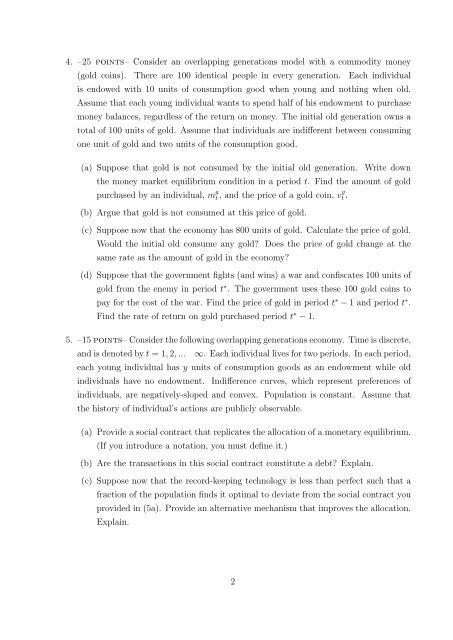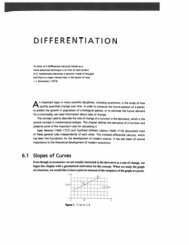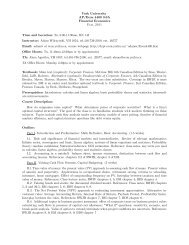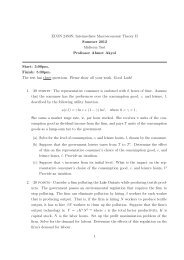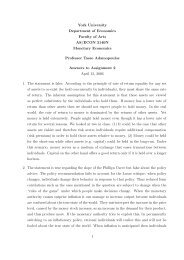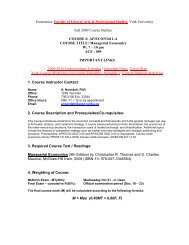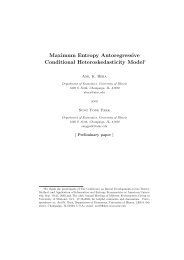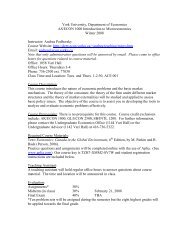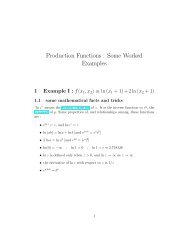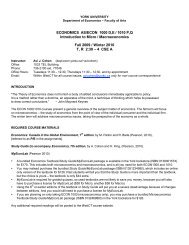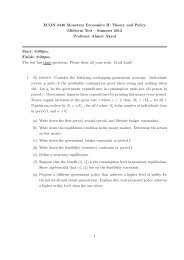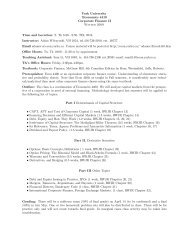ECON 3440 Monetary Economics II: Theory and Policy Midterm Test ...
ECON 3440 Monetary Economics II: Theory and Policy Midterm Test ...
ECON 3440 Monetary Economics II: Theory and Policy Midterm Test ...
- No tags were found...
Create successful ePaper yourself
Turn your PDF publications into a flip-book with our unique Google optimized e-Paper software.
4. –25 points– Consider an overlapping generations model with a commodity money(gold coins). There are 100 identical people in every generation. Each individualis endowed with 10 units of consumption good when young <strong>and</strong> nothing when old.Assume that each young individual wants to spend half of his endowment to purchasemoney balances, regardless of the return on money. The initial old generation owns atotal of 100 units of gold. Assume that individuals are indifferent between consumingone unit of gold <strong>and</strong> two units of the consumption good.(a) Suppose that gold is not consumed by the initial old generation. Write downthe money market equilibrium condition in a period t. Find the amount of goldpurchased by an individual, m g t , <strong>and</strong> the price of a gold coin, v g t .(b) Argue that gold is not consumed at this price of gold.(c) Suppose now that the economy has 800 units of gold. Calculate the price of gold.Would the initial old consume any gold? Does the price of gold change at thesame rate as the amount of gold in the economy?(d) Suppose that the government fights (<strong>and</strong> wins) a war <strong>and</strong> confiscates 100 units ofgold from the enemy in period t ∗ . The government uses these 100 gold coins topay for the cost of the war. Find the price of gold in period t ∗ − 1 <strong>and</strong> period t ∗ .Find the rate of return on gold purchased period t ∗ − 1.5. –15 points– Consider the following overlapping generations economy. Time is discrete,<strong>and</strong> is denoted by t = 1, 2, ... ∞. Each individual lives for two periods. In each period,each young individual has y units of consumption goods as an endowment while oldindividuals have no endowment. Indifference curves, which represent preferences ofindividuals, are negatively-sloped <strong>and</strong> convex. Population is constant. Assume thatthe history of individual’s actions are publicly observable.(a) Provide a social contract that replicates the allocation of a monetary equilibrium.(If you introduce a notation, you must define it.)(b) Are the transactions in this social contract constitute a debt? Explain.(c) Suppose now that the record-keeping technology is less than perfect such that afraction of the population finds it optimal to deviate from the social contract youprovided in (5a). Provide an alternative mechanism that improves the allocation.Explain.2


